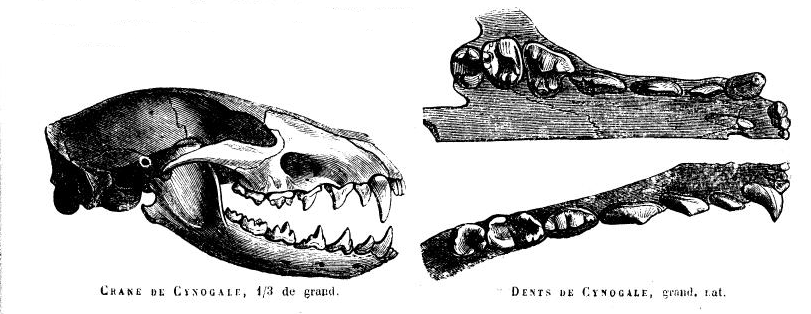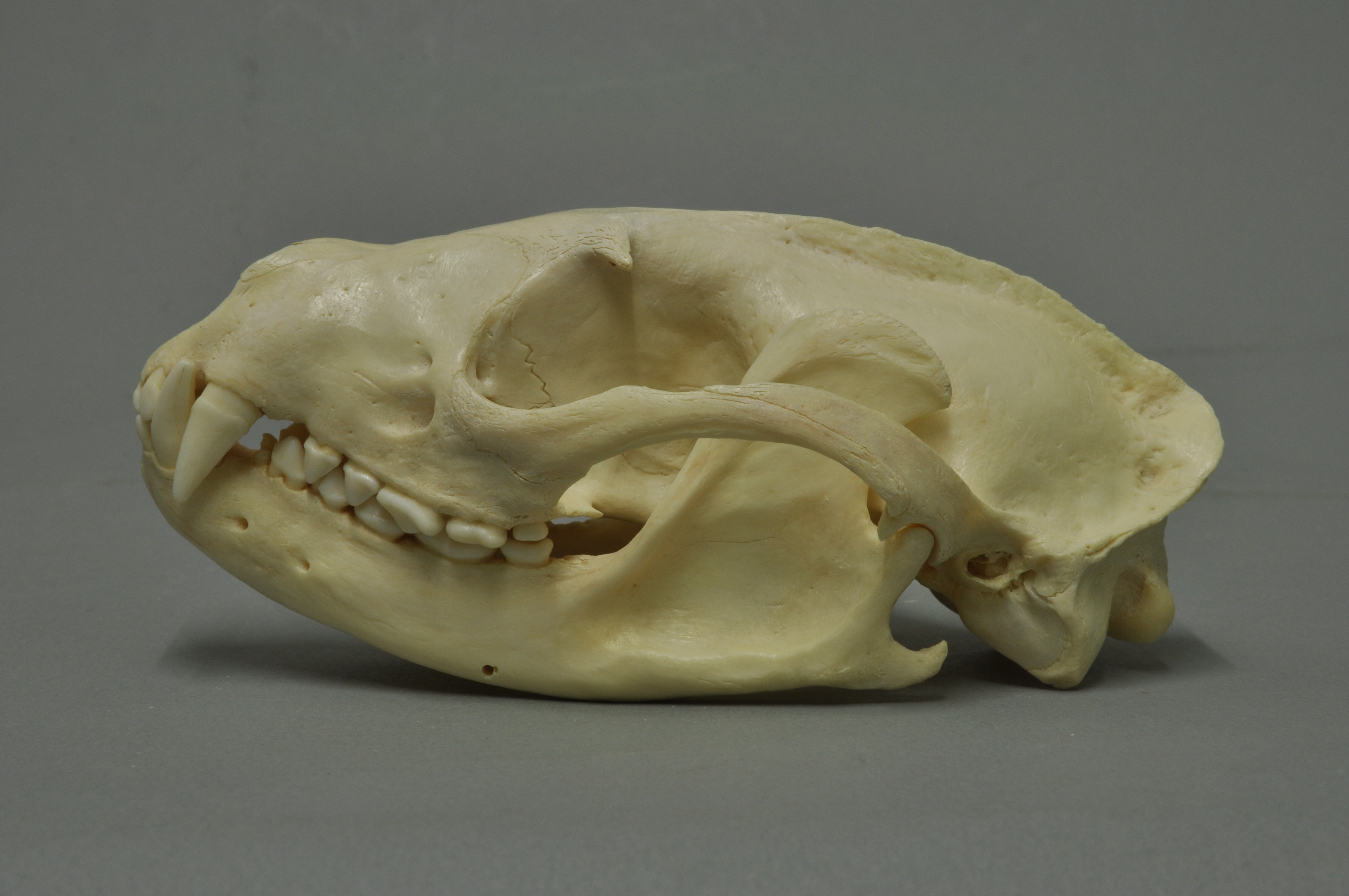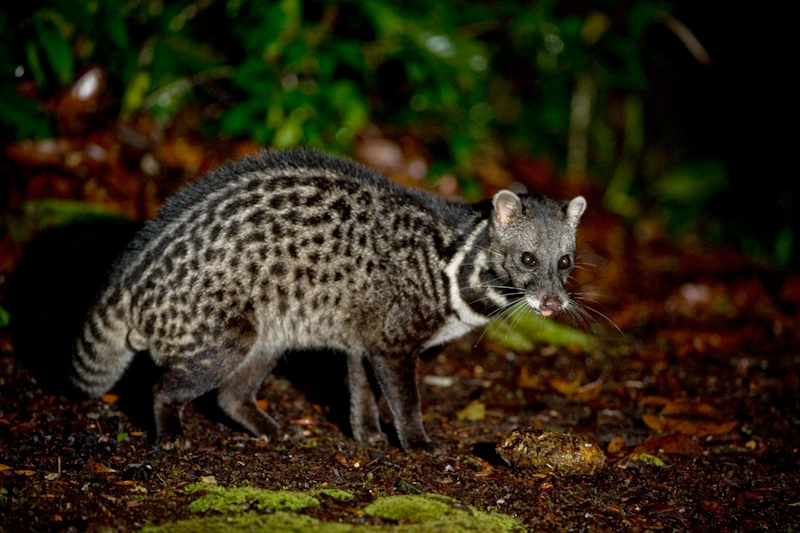|
Viverridae
Viverridae is a family of small to medium-sized, feliform mammals. The viverrids () comprise 33 species placed in 14 genera. This family was named and first described by John Edward Gray in 1821. Viverrids occur all over Africa, southern Europe, and South and Southeast Asia, across the Wallace Line. Their occurrence in Sulawesi and in some of the adjoining islands shows them to be ancient inhabitants of the Old World tropics. Characteristics Viverrids have four or five toes on each foot and half-retractile claws. They have six incisors in each jaw and molars with two tubercular grinders behind in the upper jaw, and one in the lower jaw. The tongue is rough with sharp prickles. A pouch or gland occurs beneath the anus, but there is no cecum. Viverrids are the most primitive of all the families of feliform Carnivora and clearly less specialized than the Felidae. In external characteristics, they are distinguished from the Felidae by the longer muzzle and tuft of facial vibrissae ... [...More Info...] [...Related Items...] OR: [Wikipedia] [Google] [Baidu] |
Feliform
Feliformia is a suborder within the order Carnivora consisting of "cat-like" carnivorans, including cats (large and small), hyenas, mongooses, viverrids, and related taxa. Feliformia stands in contrast to the other suborder of Carnivora, Caniformia (also Canoidea, "dog-like" carnivorans). The separation of the Carnivora into the broad groups of feliforms and caniforms is widely accepted, as is the definition of Feliformia and Caniformia as suborders (sometimes superfamilies). The classification of feliforms as part of the Feliformia suborder or under separate groupings continues to evolve. Systematic classifications dealing with only extant taxa include all feliforms into the Feliformia suborder, though variations exist in the definition and grouping of families and genera.Taxonomic references - extant species (1): Supporting descriptive information and picturesDiversity Web (online) – Feliformia/ref>Taxonomic references - extant species (2)Integrated Taxonomic Information Syst ... [...More Info...] [...Related Items...] OR: [Wikipedia] [Google] [Baidu] |
Viverrinae
The Viverrinae represent the largest subfamily within the Viverridae comprising five genera, which are subdivided into 22 species native to Africa and Southeast Asia. This subfamily was denominated and first described by John Edward Gray in 1864.Gray, J. E. (1864)''A revision of the genera and species of viverrine animals (Viverridae), founded on the collection in the British Museum'' Proceedings of the Zoological Society of London for the year 1864: 502–579. Classification Gray defined the Viverrinae as comprising the genera ''Proteles'', ''Viverra'', ''Bassaris'' and '' Viverricula''. He subordinated the genera '' Genetta'' and ''Fossa'' to the Genettina, the genera ''Prionodon'' and ''Poiana'' to the Prionodontinae. Reginald Innes Pocock suggested that the African genets (''Genetta'') are also most nearly related to the Viverrinae, but should perhaps form a separate subfamily.Pocock, R. I. (1939)''The fauna of British India, including Ceylon and Burma. Mammalia. – Volum ... [...More Info...] [...Related Items...] OR: [Wikipedia] [Google] [Baidu] |
Paradoxurinae
Paradoxurinae is a subfamily of the feliform viverrids that was denominated and first described by John Edward Gray in 1864. Pocock subordinated the genera ''Paradoxurus'', ''Paguma'' and ''Arctictis'' to this subfamily. Classification Living species Phylogenetic tree The phylogenetic relationships of Paradoxurinae are shown in the following cladogram: Extinct genera *'' Kichechia'' *'' Tugenictis'' *''Kanuites ''Kanuites'' is an extinct genus of Paradoxurinae, paradoxurine viverrid carnivore. It lived in Africa, during the Miocene epoch. Description ''Kanuites'' was about long, and looked remarkably similar to modern Genet (animal), genets. ''Kanuite ...'' *'' Siamictis'' References Viverrids Taxa named by John Edward Gray {{carnivora-stub ... [...More Info...] [...Related Items...] OR: [Wikipedia] [Google] [Baidu] |
Poiana (genus)
The African linsangs also known as oyans are two species classified in the mammalian subfamily Viverrinae, in the family Viverridae. There is one genus, ''Poiana''. The name ''linsang'' is from Javanese ''linsang'' or ''wlinsang'', which used to be wrongly translated as "otter" in English dictionaries. Linsangs are nocturnal, generally solitary tree dwellers. They are carnivorous, eating squirrels and other rodents, small birds, lizards and insects. Typical size is a little over 30 cm (1 foot), with a tail that more than doubles that length. Bodies are long, with short legs, giving a low appearance. Both species have yellowish bodies with black markings (stripes, blotches and spots), though the distribution and nature of the markings varies between the two species. Taxonomy The genus ''Poiana'' was erected by John Edward Gray in a paper read at the 8 November 1864 meeting of the Zoological Society of London and published the following year, in the ''Proceedings of the Zool ... [...More Info...] [...Related Items...] OR: [Wikipedia] [Google] [Baidu] |
Hemigalinae
The Hemigalinae are a subfamily of the viverrids denominated and first described by John Edward Gray in 1864. Hemigalinae species are native to Southeast Asia from southern China through Indochina, Malay Peninsula to Sumatra, Borneo and Sulawesi. Characteristics The tails of Hemigalinae species are ringed. The toes and the middle of the lower part of the tarsus are bald. The frenum, upper part, and sides of the lower part are hairy. The orbit is imperfect. Hemigalinae resemble the Viverrinae in having the scent glands present in both sexes and wholly perineal, but differing by their simpler structure, consisting in the male of a shallower, smaller pouch, with less tumid lips, situated midway between the scrotum and the penis, but not extending to either. In the female, the scent glands consist of a pair of swellings, each with a slit-like orifice, situated one on each side of the vulva and a little behind it and on a common eminence, the perineal area behind this eminence being ... [...More Info...] [...Related Items...] OR: [Wikipedia] [Google] [Baidu] |
Binturong
The binturong (''Arctictis binturong'') (, ), also known as the bearcat, is a viverrid native to South and Southeast Asia. It is uncommon in much of its range, and has been assessed as Vulnerable on the IUCN Red List because of a declining population trend that is estimated at more than 30% since the mid-1980s. The binturong is the only living species in the genus ''Arctictis''. Etymology The name ''Arctictis'' means 'bear-weasel', from Greek '' arkt-'' 'bear' + '' iktis'' 'weasel'. In Riau, Indonesia it is called 'benturong' and 'tenturun'. Its common name in Borneo is "binturong", which is related to the Western Malayo-Polynesian root "ma-tuRun". Taxonomy ''Viverra binturong'' was the scientific name proposed by Thomas Stamford Raffles in 1822 for a specimen from Malacca. The generic name ''Arctictis'' was proposed by Coenraad Jacob Temminck in 1824. ''Arctictis'' is a monotypic taxon; its morphology is similar to that of members of the genera ''Paradoxurus'' and ''Paguma'' ... [...More Info...] [...Related Items...] OR: [Wikipedia] [Google] [Baidu] |
Arctictis
The binturong (''Arctictis binturong'') (, ), also known as the bearcat, is a viverrid native to South and Southeast Asia. It is uncommon in much of its range, and has been assessed as Vulnerable on the IUCN Red List because of a declining population trend that is estimated at more than 30% since the mid-1980s. The binturong is the only living species in the genus ''Arctictis''. Etymology The name ''Arctictis'' means 'bear-weasel', from Greek '' arkt-'' 'bear' + '' iktis'' 'weasel'. In Riau, Indonesia it is called 'benturong' and 'tenturun'. Its common name in Borneo is "binturong", which is related to the Western Malayo-Polynesian root "ma-tuRun". Taxonomy ''Viverra binturong'' was the scientific name proposed by Thomas Stamford Raffles in 1822 for a specimen from Malacca. The generic name ''Arctictis'' was proposed by Coenraad Jacob Temminck in 1824. ''Arctictis'' is a monotypic taxon; its morphology is similar to that of members of the genera ''Paradoxurus'' and ''Paguma'' ... [...More Info...] [...Related Items...] OR: [Wikipedia] [Google] [Baidu] |
Arctogalidia
The small-toothed palm civet (''Arctogalidia trivirgata''), also known as the three-striped palm civet, is a palm civet native to dense forests of Southeast Asia, from the Assam district of India to Indochina and the Malay Peninsula and on Sumatra, Bangka, Java, Borneo, and numerous small nearby islands of Indonesia. The first scientific description by John Edward Gray in 1832 was based on a zoological specimen from the Maluku Islands in the collection of the Rijksmuseum van Natuurlijke Historie in Leiden, Netherlands. It is blackish grey, has black paws and three black longitudinal stripes on the back. A monotypic genus, ''Arctogalidia'' means ‘bear-weasel’ (from ancient Greek '' arkto-'' ‘bear’ + ''galidia'' ‘little weasel’). The specific epithet ''trivirgata'' means ‘three-striped’ in Latin. The small-toothed palm civet is mid-sized by the standards of its family, weighing 2.4 kg (5.3 lbs) and measuring 53 cm (21 in) long along the body, ... [...More Info...] [...Related Items...] OR: [Wikipedia] [Google] [Baidu] |
Paradoxurus
''Paradoxurus'' is a genus of three palm civets within the viverrid family that was denominated and first described by Frédéric Cuvier in 1822. The ''Paradoxurus'' species have a broad head, a narrow muzzle with a large rhinarium that is deeply sulcate in the middle. Their large ears are rounded at the tip. The tail is nearly as long as the head and body. The three species are the Asian palm civet, the Golden palm civet, and the Brown palm civet. Characteristics ''Paradoxurus'' species have a broad head, a narrow muzzle with a large rhinarium that is deeply sulcate in the middle. Their large ears are rounded at the tip, the interior ridges and bursae are well developed. The skull exhibits marked muscular moulding, and the postorbital area is deeply constricted shortly behind the well-developed postorbital processes. It is considerably narrower than the interorbital area and than the muzzle above the canines. The dental formula is . The palate is not produced behind to cove ... [...More Info...] [...Related Items...] OR: [Wikipedia] [Google] [Baidu] |
Cynogale
The otter civet (''Cynogale bennettii'') is a semiaquatic viverrid native to Thailand, Malaysia, Indonesia and Brunei. It is listed as Endangered because of a serious ongoing population decline, estimated to be more than 50% over the past three generations (estimated to be 15 years), inferred from direct habitat destruction, and indirect inferred declines due to pollutants. ''Cynogale'' is a monospecific genus. Characteristics The otter civet possesses several adaptations to its habitat, including a broad mouth and webbed feet with naked soles and long claws. Its muzzle is long with numerous long whiskers. It is in many ways similar to the Hose's palm civet (''Diplogale hosei'') but has a shorter tail and no whitish underparts. Distribution and habitat Otter civets are distributed in Sumatra, Borneo and peninsular Thailand. Preferred habitat appears to be lowland primary forest, but they have also been recorded in secondary forest, bamboo and logged forest. The supposed ori ... [...More Info...] [...Related Items...] OR: [Wikipedia] [Google] [Baidu] |
Paguma
The masked palm civet (''Paguma larvata''), also called the gem-faced civet, is a palm civet species native to the Indian subcontinent and Southeast Asia. It has been listed as least concern on the IUCN Red List since 2008 as it occurs in many protected areas, is tolerant to some degree of habitat modification, and widely distributed with presumed large populations that are unlikely to be declining. The genus ''Paguma'' was first named and described by John Edward Gray in 1831. All described forms are regarded as a single species. In 2003, masked palm civets at a wildlife market in China were found to have been infected with the severe acute respiratory syndrome coronavirus. Characteristics The masked palm civet's fur is grayish to ochraceous, black on the head, shoulders and neck, and blackish brown on the tail and feet. It has a white blaze on the forehead; white marks above and below the eyes extend to the ears, forming a half-collar. In morphology the masked palm civet ... [...More Info...] [...Related Items...] OR: [Wikipedia] [Google] [Baidu] |
Viverra
''Viverra'' is a mammalian genus that was first nominated and described by Carl Linnaeus in 1758 as comprising several species including the large Indian civet (''V. zibetha''). The genus was subordinated to the viverrid family by John Edward Gray in 1821. Characteristics ''Viverra'' species are distinguished externally from the other genera of the Viverrinae by the structure of the fore feet: the third and fourth digits have lobes of skin, which act as protective sheaths for the retractile claws. The pads of the feet are surrounded by hair. They have a long and narrow skull, with narrow, nearly parallel-sided, not strongly constricted waist. Their postorbital processes are small and a little in front of the middle point between the tip of the premaxillae in front and of the occipital crest behind. The sagittal crest is moderately strong in adults. The sub-orbital portion of the cheek is comparatively short. The suture between the anterior bone of the zygomatic arch and the maxil ... [...More Info...] [...Related Items...] OR: [Wikipedia] [Google] [Baidu] |



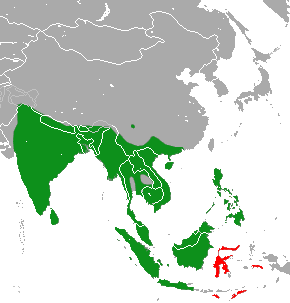


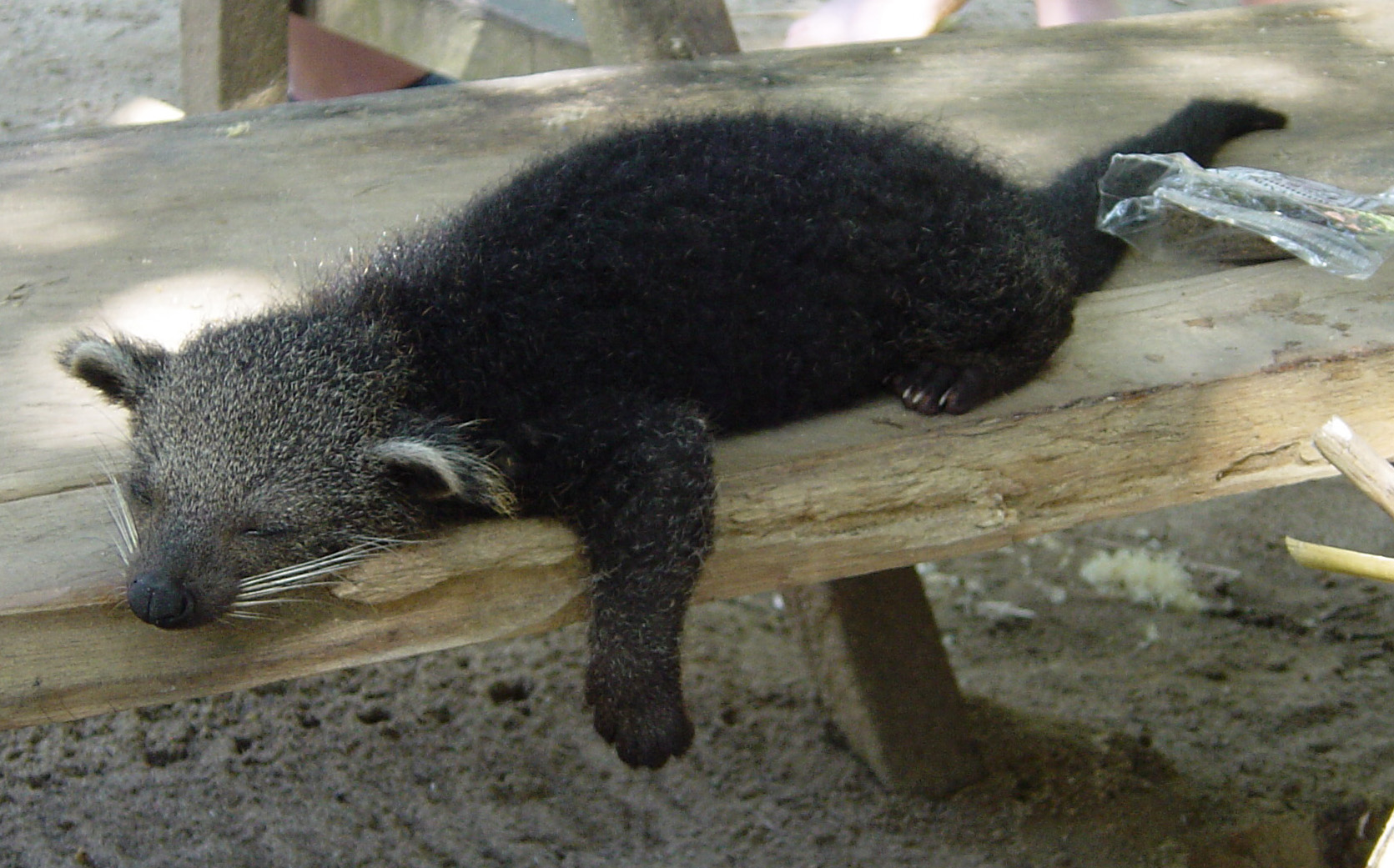
.jpg)
